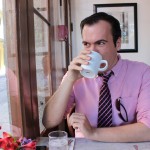Startled by a traffic accident during the first week of classes, CWRU students now find themselves at a University highly committed to producing a safer environment for the entire campus community.
In response to the increasing congestion and construction plaguing the intersection of Euclid Avenue and Adelbert Road, University Administration has now placed a resolution written by Undergraduate Student Government president Minh-Tri Nguyen on the fast track for implementation. Last November, Nguyen observed the over abundance of foot and motor traffic at the intersection of Euclid and Adelbert, prompting him to write a resolution that would address the overcrowding. The resolution calls for the University Hospitals sign and the retaining wall adjacent to the Allen Memorial Medical Library to be removed and a queuing area for students to be constructed in their place.
According to vice president of administration John Wheeler, “the USG initiative is at the top of our priority list, for the safety of students will always be our primary concern.” Vice president Wheeler also stressed the Administration’s value of student input and noted that COMPASS , or the Committee on Master Planning and Student Space, will be working hand in hand with USG and university architect Margaret Carney to achieve the desired outcome. COMPASS was an organization formed by USG President Nguyen last fall to act as a student focus group.
Nguyen explains that, while in its infancy, COMPASS provides “a group of students to talk about current and future projects [in order] to gain student feedback.” Often partnering with the university architect, the group tackles aesthetic issues on campus and played an instrumental role in encouraging the University to reduce its carbon emissions. Nguyen describes COMPASS as a “brother or sister of USG,” making it the perfect student group to participate in this new safety initiative.
Originally hoping to see the implementation of his resolution during the summer months when CWRU student foot traffic was at a minimum, Nguyen does realize the potential problems that new construction at the intersection could pose for pedestrians. However, the benefits of the change will prove to outweigh the brief inconvenience it presents for walkers and bikers.
Desiring to see progress made before the start of the spring semester, USG and CWRU administration are now planning the project and discussing it with University Hospitals, who are not expected to object to the sign removal. “This is considered by the administration as a life safety issue,” Senior Vice President Wheeler states. “The initial funding [for the operation] will come from our general fund,” he says, and “[t]he administration will look into further funding for a nice wall and benches to spruce the area up in the future.”
In addition to USG and administration action, multiple ideas to lessen the congestion at this campus nucleus have been proposed; however, not all suggestions are feasible for the University. For instance, Senior Vice President Wheeler notes that talks are being held with the City of Cleveland to stop traffic at all three points of the intersection and allow students to cross diagonally into the quad. However, because of traffic concerns, it is expected that Cleveland will not comply with the request. Since CWRU owns the land around the University Hospitals sign at the corner of Euclid Avenue and Adelbert Road, an expansion of this area would directly address the issue of overcrowding. The queuing area would not only create more space for students to wait, but would also put distance between pedestrians and the roadway.
Though this congestion solution has not completely materialized, CWRU is taking a current and active stance in promoting student safety across the campus. For instance, on Aug. 29, CWRU police officer Mark Chavis, senior chemistry instructor Michael Kenney, and USG vice president of student life Divya Aggarwal visited multiple freshman residential buildings in order to promote safety and community to first year students. Through this brief seminar, attendees gained information on the multiple campus services available to assist students with a variety of problems and the safety measures in place to keep the community safe. Students also received education on their own personal responsibility to safety, for something as simple as reducing the volume of one’s iPod could prove critical in preventing harm. The theme of safety was also reinforced at a Campus Safety Fair held on Sept. 7 on the South Quad, in which students were able to view the multiple organizations and departments that help maintain a healthy and secure campus.


